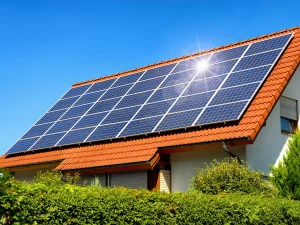A solar power system, also known as a solar photovoltaic (PV) system, is a renewable energy technology that harnesses sunlight and converts it into electricity. Solar power systems are becoming increasingly popular due to their environmental benefits, energy cost savings, and potential for energy independence.
A typical solar power system consists of the following components:
- Solar Panels: Solar panels, also called solar modules, are made up of solar cells that convert sunlight into direct current (DC) electricity. They are usually mounted on the roof or in an open area where they can receive maximum sunlight exposure.
- Inverter: The DC electricity generated by the solar panels needs to be converted into alternating current (AC) electricity, which is the type of electricity used in most homes and businesses. The inverter is the component responsible for this conversion.
- Mounting and Racking System: Solar panels need to be securely mounted on rooftops or the ground. The mounting and racking system provides structural support and ensures that the panels are properly angled to capture sunlight effectively.
- Monitoring System: Many solar power systems come with monitoring systems that allow homeowners or business owners to track the performance of their solar panels and monitor the energy production.
- Battery (Optional): Some solar power systems are equipped with battery storage, allowing excess electricity generated during sunny periods to be stored for later use when the sun is not shining, such as during the night or on cloudy days.
How solar power systems work:
- Sunlight hits the solar panels, and the solar cells within the panels absorb the photons present in sunlight.
- The absorbed sunlight creates an electric field across the solar cells, generating direct current (DC) electricity.
- The DC electricity produced by the solar panels is sent to the inverter, which converts it into alternating current (AC) electricity that can be used to power electrical appliances and devices in homes or businesses.
- The AC electricity is then distributed throughout the building’s electrical system to power lights, appliances, electronics, and other electrical loads.
- If the solar power system has a battery storage component, excess electricity that is not immediately used can be stored in the batteries for later use.
The amount of electricity generated by a solar power system depends on factors such as the size of the system, the efficiency of the solar panels, the location of the installation, and the amount of sunlight the system receives.
Solar power systems offer numerous benefits, including reduced electricity bills, lower carbon emissions, and a reliable and sustainable source of energy. Many governments and utilities also offer incentives and rebates to encourage the adoption of solar power systems, making them an attractive option for those looking to go green and save on energy costs.
